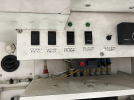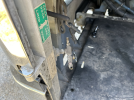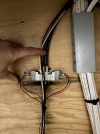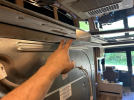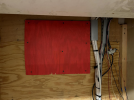I've been mostly absent during the summer because we've been off doing things. It's been a busy summer - we were traveling for something around 5 weeks of it on two separate trips, covering something around 3-4,000 miles or so in that timeframe. The bus performed (mostly) flawlessly.
The first trip involved going to Colorado. This was the trip where we had an issue. About 50 miles east of Denver, the speedometer started acting up, eventually quit entirely, and the transmission wouldn't shift. It eventually went into limp mode. For those who are familiar with that part of Colorado on I-70, there's a whole lot of nothing out there, and it's far apart. We ended up making it to a relatively sketchy gas station parking lot off the highway where I'm pretty sure drug deals were happening overnight, but nobody bothered us.
The Prevost community is remarkably good, although as is often the case with these sorts of scenarios I got a list of all of the "common" things that go wrong, none of which ended up applying to me. A huge benefit of a bus like this is that Prevost publishes all of the wiring diagrams and maintenance manuals online, freely accessible. And, fortunately as well, we actually had cell signal and thus internet where we were. Unfortunately, I had forgotten to pack my multimeter, which ended up meaning I had to disconnect the Jeep and drive to the next town (which would've been a much better place to limp to since it not only had a NAPA but a KOA) and then buy a multimeter. So, now the bus has a multimeter and the shop has one too. Now I just have to remember to leave the bus one in the bus.
The problem ended up being a single connector with a single pin in it that connects the ground for the transmission computer. That pin was bent and the connector itself was melted. I honestly have no idea how that even ever worked in the first place - someone had obviously put it together wrong. But once I found it (which took hours of troubleshooting, diagnostics, and reading wiring diagrams) it was about a 30 second fix to delete the connector, crimp the wires together, and everything worked properly again. Overall for 50,000 miles of operating 20+ year old busses/RVs, we've had relatively few issues, and they've all (knock on wood) been easy to address so far.
I also learned some interesting things about the limp mode on the transmission. If the transmission stops receiving data it's supposed to and goes into limp mode, it will stay in whatever gear it's in until you pull the parking brake. At that point, it will stick in 2nd gear, non-lockup, and that's what you've got. I had to stop because I saw something in my rear view mirrors that looked like it required attention, and so after that stop then I was stuck in 2nd gear non-lockup. Normally on this transmission it hits lockup in 2nd gear and all other gears stay locked up, and so 50,000 lbs with a non-locked-up torque converter will generate a lot of heat. Without the transmission computer, you also have zero idea what your transmission temperature is, and burning up that transmission is something I want to avoid, which is why I didn't keep on limping. Once you then shut off the bus, the transmission will not go into any gear and you're stuck where you are.
Before that trip, I had replaced the exhaust rockers and done an overhead adjustment. I had screwed up the valve cover gasket installation (access wasn't good and I have since learned a few tricks) and so there was a mess of oil behidn the bus that got on the Jeep. That got fixed before the second trip.
Our second trip involved going to Ohio for a race at the race track in Lexington, followed by West Virginia. In the mountains of West Virginia I started noticing the engine running warm, something that made absolutely no sense given the fact that this bus has a very good cooling system. I ended up finding the problem. Off of the crankshaft there are 3 V-belts that drive a gearbox which then drives the engine cooling fan and the AC compressor. One of those belts had snapped and so it was running on 2. The 2 belts can run the fan, but not with the added horsepower demand of the AC compressor. And, those are large belts which are hard to find and I didn't have spares. The local parts store was able to get 2 in before we left our campsite in West Virginia, but not a 3rd. And the new belts were noticeably shorter than the shrunken (probably from slipping/heating) belts. So I disconnected the engine-driven AC compressor clutch such that it couldn't turn on (it will turn on under engine braking even if you've got the AC turned off) and we went home that way. No issues, other than it really does need that extra AC up front driving down the road in the summer with the sun in your face, so I was a bit warm. But we had one stint where we ran the generator for 5 days straight, and another where it ran for 3 days straight, and it performed flawlessly. One interesting note is that the generator has alwasy felt like it was vibrating more than it should. Once it had been running for a while, it was definitely quieter and the vibration went away. I'm wondering if it may have had a partly clogged injector that freed up after a long, harder run like that (it was hot and we had all 3 ACs going full blast for most of the time).
I can say with confidence that the fuel economy has gone up after the overhead, which isn't surprising. There were several valves that were off by a decent bit, although nothing that was truly concerning.
Now that we're back home, I'm going through some lower priority/clean-up items that I've wanted to do but haven't had a chance to. To start off, although the generator is now a bit quieter than it was, the amount I want to hear a generator is zero. Additionally, one issue that this thing has always had is that the passageway that provides air to the engine has openings without any kind of mesh or covering on them that bugs could easily get into, or even small birds for making a nest. That passageway was also just plywood, which reverberated sounds a lot, and it lets out on the passenger side of the bus, which is where you normally have your picnic table or things like that. So, I added some mesh wire to prevent stuff from getting in, and then I also added some sound absorbing foam to the passageway which should help to reduce the noise. I didn't put any kind of Dynamat or the like down first, and now am somewhat wondering if I should have, but hopefully this will make an incremental improvement.
The exterior lighting needed improvement in some areas. One is that this bus (along with a lot of other higher end coaches) have exterior "docking/cornering" lights which turn on to illuminate the areas on either side of the bus when turning or parking at night. This is really nice on dark, unlit roads. The factory lights are standard sealed beam enclosures. These days, there are LED units that are much brighter. I put those in, the difference is immediately hugely noticeable.
The rear lights were another item. The 3rd brake light (which is LED) had a coule of burned out LEDs. Ordered a new one and replaced that.
The rest of the rear lights are 1156 bulbs, a total of 20 of them. Yes, 20. And this thing seems to eat the bulbs. I decided to try to find some LEDs for at least some of the lights that would help. About a year ago a company had sent me some LED headlight buls for my Ram to try out, and I've been impressed with them. So I ordered some more from the same brand, which so far I'm happy with. At this point I haven't changed out all the bulbs, but I will probably change them all out with time as they burn out. For those who're interested, this is what I used:
Make sure you order them for the correct color of your lens to get the maximum output.
The next area that needed attention was the forward lighting. I have never been happy with this, and when you're driving a bus that weighs 50,000 lbs at night on dark empty roads, lots of forward visibility is nice. The people I bought the bus from had installed the nice and expensive LED headlight upgrade, and then proceeded to completely screw up the aim and wiring on it. I got those aimed better now, but the driving lights were basically useless. Upon investigation, this was an annoying thing, the people I bought it from had installed... literally $17 Amazon lED driving lights. No wonder they're terrible. I removed them and am going to repurpose them in the back of the bus to add in some more engine bay lighting.
I ended up deciding to go with a two-pronged approach. I added in some new driving lights in the same area, and then also added in a light bar as there's a spot where I could fit a 30" one nicely. Based on the intial checks, this setup is very bring, looks to be well focused light at that, and I think will improve my night driving significantly.
With my box of parts from Prevost, I also had ordered a new belt tensioner for the big 8-rib engine belt which drives the 500A (at 24V!) alternator and the water pump. During some previous work, I'd noticed that the tensioner had felt a little crunchy when removing the belt. Sure enough, upon removing it it was obvious that it was falling apart. Good preventative maintenance. That belt looks just fine, so I left it be.
There are a few new videos about work I've done on my YouTube channel for those who are interested.



